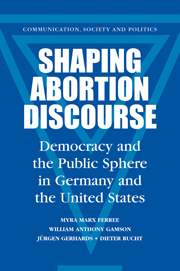Part II - Major Outcomes
Published online by Cambridge University Press: 15 December 2009
Summary
This part analyzes the different playing fields in Germany and the United States on which various collective actors attempt to shape the meaning of abortion and presents the results on our two major outcome variables: standing and framing. Chapter Four focuses on the playing fields themselves and looks at how the politics and culture of the two countries vary in ways that inevitably influence who receives standing and which frames are easy or difficult to express. We emphasize not only the formal institutional roles of churches and parties but also media expectations. Also, German political culture gives the state more generally accepted responsibility for the welfare and support for families.
Chapter Five looks at which actors receive standing in the mass media and how this has changed over time. Standing, or the ability to have one's views transmitted through the media, is a resource that is conferred more on political parties in Germany and shared more equally with social movements in the United States. This chapter compares the organization, resources, and media relations skills of similar groups of actors in each country as a way of understanding why some are more successful, even when recognizing that the playing field is more advantageous for some than for others.
Chapter Six provides an overview of the framing contest on abortion in the two countries and how the careers of different frames have changed over time. We see some differences that we would expect. The different framing by the courts is reflected in a more Fetal Life framing in the mass media discourse in Germany and a more Individual and State framing in U.S. media discourse.
- Type
- Chapter
- Information
- Shaping Abortion DiscourseDemocracy and the Public Sphere in Germany and the United States, pp. 59 - 60Publisher: Cambridge University PressPrint publication year: 2002



